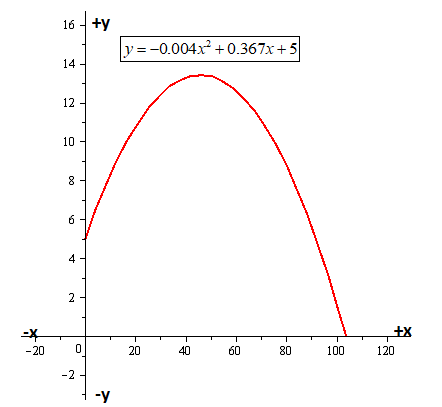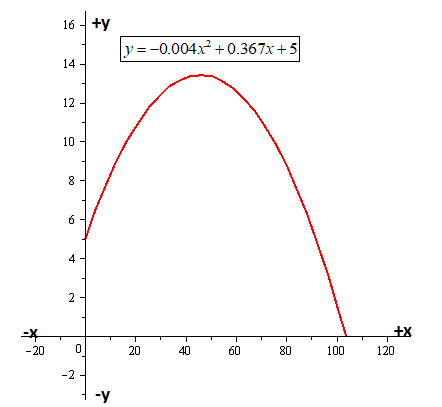
Concept explainers
a.
Use a system of equations to find the equation of the parabola
a.
Answer to Problem 96E
Explanation of Solution
Given information:
A video of the path of a ball thrown by a baseball player was analyzed with a grid covering the TV screen. The video was paused three times, and the position of the ball was measured each time. The coordinates obtained are shown in the table. (

Calculation:
The given form of equation of parabola is,
Parabola passes through the points
Now parabola passes through the points
When parabola passes through the points
Now equation
Now use graphing calculator to write the matrix in reduced row-echelon form and we get the reduced row-echelon matrix,
Hence, the equation of parabola is,
b.
Use a graphing utility to graph the parabola.
b.
Answer to Problem 96E

Explanation of Solution
Given information:
A video of the path of a ball thrown by a baseball player was analyzed with a grid covering the TV screen. The video was paused three times, and the position of the ball was measured each time. The coordinates obtained are shown in the table. (

Calculation:
The graph of the parabola is as shown,

Hence, the graph of parabola is plotted.
c.
Graphically approximate the maximum height of the ball and the point at which the ball struck the ground.
c.
Answer to Problem 96E
Explanation of Solution
Given information:
A video of the path of a ball thrown by a baseball player was analyzed with a grid covering the TV screen. The video was paused three times, and the position of the ball was measured each time. The coordinates obtained are shown in the table. (

Calculation:
According to the graph the maximum height of the ball is
The point at which the ball struck the ground is
d.
Analytically find the maximum height of the ball and the point at which the ball struck the ground.
d.
Answer to Problem 96E
Explanation of Solution
Given information:
A video of the path of a ball thrown by a baseball player was analyzed with a grid covering the TV screen. The video was paused three times, and the position of the ball was measured each time. The coordinates obtained are shown in the table. (

Calculation:
Consider the equation of parabola
Now calculate the maximum height of the ball with calculus theory,
For a function
Now we have,
Now the maximum height is put
Now the point at which the ball struck the ground is,
Hence, calculated results are
e.
Compare your results from parts (c) and (d).
e.
Answer to Problem 96E
Both results are similar.
Explanation of Solution
Given information:
A video of the path of a ball thrown by a baseball player was analyzed with a grid covering the TV screen. The video was paused three times, and the position of the ball was measured each time. The coordinates obtained are shown in the table. (

Calculation:
The result from graphically and analytically method, both are similar.
Hence, both results are similar.
Chapter 8 Solutions
EBK PRECALCULUS W/LIMITS
- Which of the following is the general solution to y′′ + 4y = e^2t + 12 sin(2t) ?A. y(t) = c1 cos(2t) + c2 sin(2t) + 1/8 e^2t − 3t cos(2t)B. y(t) = c1e^2t + c2e^−2t + 1/4 te^2t − 3t cos(2t)C. y(t) = c1 + c2e^−4t + 1/12 te^2t − 3t cos(2t)D. y(t) = c1 cos(2t) + c2 sin(2t) + 1/8 e^2t + 3 sin(2t)E. None of the above. Please include all steps! Thank you!arrow_forwardShow that i cote +1 = cosec 20 tan 20+1 = sec² O २ cos² + sin 20 = 1 using pythagon's theoremarrow_forwardFind the general solution to the differential equationarrow_forward
- charity savings Budget for May travel food Peter earned $700 during May. The graph shows how the money was used. What fraction was clothes? O Search Submit clothes leisurearrow_forwardExercise 11.3 A slope field is given for the equation y' = 4y+4. (a) Sketch the particular solution that corresponds to y(0) = −2 (b) Find the constant solution (c) For what initial conditions y(0) is the solution increasing? (d) For what initial conditions y(0) is the solution decreasing? (e) Verify these results using only the differential equation y' = 4y+4.arrow_forwardAphids are discovered in a pear orchard. The Department of Agriculture has determined that the population of aphids t hours after the orchard has been sprayed is approximated by N(t)=1800−3tln(0.17t)+t where 0<t≤1000. Step 1 of 2: Find N(63). Round to the nearest whole number.arrow_forward
- 3. [-/3 Points] DETAILS MY NOTES SCALCET8 7.4.032. ASK YOUR TEACHER PRACTICE ANOTHER Evaluate the integral. X + 4x + 13 Need Help? Read It SUBMIT ANSWER dxarrow_forwardEvaluate the limit, and show your answer to 4 decimals if necessary. Iz² - y²z lim (x,y,z)>(9,6,4) xyz 1 -arrow_forwardlim (x,y) (1,1) 16x18 - 16y18 429-4y⁹arrow_forward
- Evaluate the limit along the stated paths, or type "DNE" if the limit Does Not Exist: lim xy+y³ (x,y)(0,0) x²+ y² Along the path = = 0: Along the path y = = 0: Along the path y = 2x:arrow_forwardshow workarrow_forwardA graph of the function f is given below: Study the graph of ƒ at the value given below. Select each of the following that applies for the value a = 1 Of is defined at a. If is not defined at x = a. Of is continuous at x = a. If is discontinuous at x = a. Of is smooth at x = a. Of is not smooth at = a. If has a horizontal tangent line at = a. f has a vertical tangent line at x = a. Of has a oblique/slanted tangent line at x = a. If has no tangent line at x = a. f(a + h) - f(a) lim is finite. h→0 h f(a + h) - f(a) lim h->0+ and lim h h->0- f(a + h) - f(a) h are infinite. lim does not exist. h→0 f(a+h) - f(a) h f'(a) is defined. f'(a) is undefined. If is differentiable at x = a. If is not differentiable at x = a.arrow_forward
 Calculus: Early TranscendentalsCalculusISBN:9781285741550Author:James StewartPublisher:Cengage Learning
Calculus: Early TranscendentalsCalculusISBN:9781285741550Author:James StewartPublisher:Cengage Learning Thomas' Calculus (14th Edition)CalculusISBN:9780134438986Author:Joel R. Hass, Christopher E. Heil, Maurice D. WeirPublisher:PEARSON
Thomas' Calculus (14th Edition)CalculusISBN:9780134438986Author:Joel R. Hass, Christopher E. Heil, Maurice D. WeirPublisher:PEARSON Calculus: Early Transcendentals (3rd Edition)CalculusISBN:9780134763644Author:William L. Briggs, Lyle Cochran, Bernard Gillett, Eric SchulzPublisher:PEARSON
Calculus: Early Transcendentals (3rd Edition)CalculusISBN:9780134763644Author:William L. Briggs, Lyle Cochran, Bernard Gillett, Eric SchulzPublisher:PEARSON Calculus: Early TranscendentalsCalculusISBN:9781319050740Author:Jon Rogawski, Colin Adams, Robert FranzosaPublisher:W. H. Freeman
Calculus: Early TranscendentalsCalculusISBN:9781319050740Author:Jon Rogawski, Colin Adams, Robert FranzosaPublisher:W. H. Freeman
 Calculus: Early Transcendental FunctionsCalculusISBN:9781337552516Author:Ron Larson, Bruce H. EdwardsPublisher:Cengage Learning
Calculus: Early Transcendental FunctionsCalculusISBN:9781337552516Author:Ron Larson, Bruce H. EdwardsPublisher:Cengage Learning





